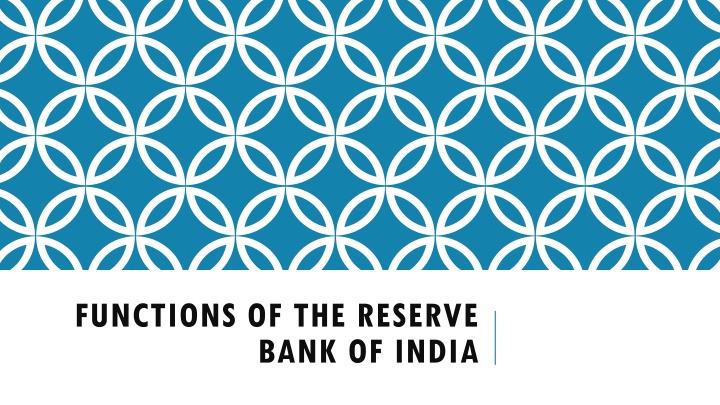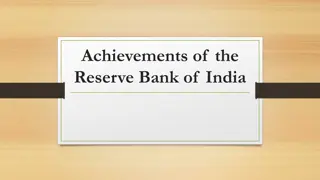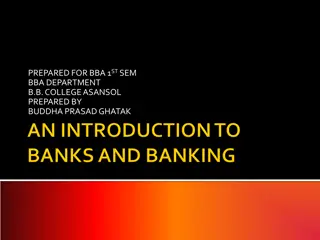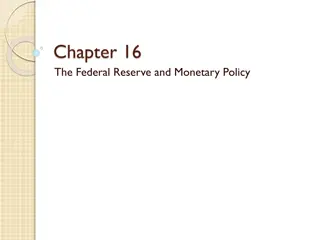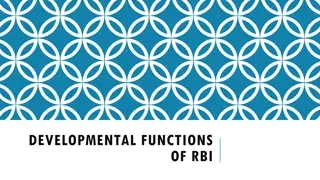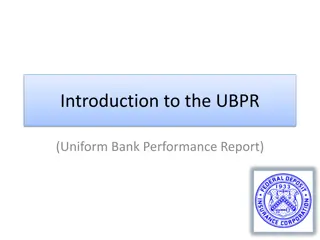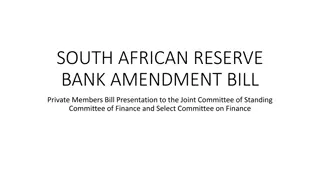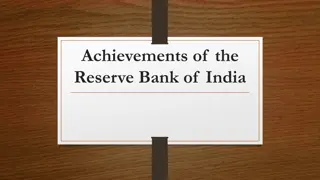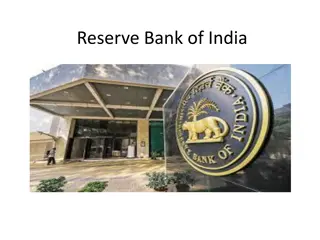Functions of the Reserve Bank of India
The Reserve Bank of India plays a crucial role in regulating the monetary system to achieve economic growth and stability. It performs traditional functions, including central banking functions like issuing currency, regulating credit, and acting as the banker's bank. The RBI's functions are categorized into traditional and development functions to ensure the stability and efficiency of the financial system in India.
Download Presentation

Please find below an Image/Link to download the presentation.
The content on the website is provided AS IS for your information and personal use only. It may not be sold, licensed, or shared on other websites without obtaining consent from the author.If you encounter any issues during the download, it is possible that the publisher has removed the file from their server.
You are allowed to download the files provided on this website for personal or commercial use, subject to the condition that they are used lawfully. All files are the property of their respective owners.
The content on the website is provided AS IS for your information and personal use only. It may not be sold, licensed, or shared on other websites without obtaining consent from the author.
E N D
Presentation Transcript
FUNCTIONS OF THE RESERVE BANK OF INDIA
FUNCTIONS OF THE RESERVE BANK OF INDIA The main function of Reserve Bank of India is to regulate the monetary system of the country in such a way that the balance of economic growth of the country is achieved along with economic stability. According to the Preamble of RBI Act, 1934, "The main functions of the bank are to regulate the issue of bank notes and keeping of reserve with view to securing monetary stability in India and generally to operate the currency and credit system of the country to its advantage."
FUNCTIONS OF RESERVE BANK OF INDIA Functions of Reserve Bank of India may be broadly classified into two categories. (I) Traditional Functions (II) Development Functions.
I. TRADITIONAL FUNCTIONS The traditional functions of RBI are further divided into three types (A) Central Banking Functions. (B) General Banking Functions. (C) Prohibitory Functions.
(A) CENTRAL BANKING FUNCTIONS: Reserve Bank of India is the central bank of India. Its Central Banking functions are as under- 1. Issue of Paper Currency: Reserve Bank of India has the sole right to issue bank note of all denominations except one rupee note which is issued by the Government of India. RBI issues notes of the denomination of 2, 5,10, 20, 50, 100, 500 and 1000. The bank has its separate department for note issuing. This is known as Issue Department. The Bank follows the 'Minimum Reserve System' for issue of bank notes.
(A) CENTRAL BANKING FUNCTIONS: 2. Regulation of Credit: Regulation of credit refers to control over the credit policy of the commercial banks. As the central bank, RBI controls the creation of credit by the commercial Banks. According to the Reserve Bank of India Act, the RBI can adopt dent methods of credit control such as Bank rate, open market operation, change in selective methods to control the credit of commercial bank.
(A) CENTRAL BANKING FUNCTIONS: 3. Banker's Bank: The Reserve Bank of India acts as the bank of all the Banks in the country. The scheduled banks are required to maintain with the Reserve Bank as cash certain percentage of their time and demand liabilities. It acts as a lender of last resort to them. The scheduled banks can borrow money from the Reserve Bank on the eligible securities or get financial accommodation at the times of need or stringency by rediscounting their bills of exchange. So RBI gives loans to the commercial hark during time of emergency.
(A) CENTRAL BANKING FUNCTIONS: 4. Banker of the Government: The Reserve Bank of India acts as the Banker to Government. It accepts money for the account of Union and State Governments in India, makes payment on their behalf, carries out their exchange remittance and other banking operations and manages the public debt. It makes ways and means advances to the Government for 90 days. It advises the Government on all monetary and banking matters.
(A) CENTRAL BANKING FUNCTIONS: 5. Regulation of Foreign Exchange: The Reserve Bank has been entrusted with the responsibility of maintaining the external value of the rupee and for this purpose the bank holds most of the foreign exchange reserves. Since India is a member of International Monetary Fund, the Reserve Bank has to maintain fixed exchange rates with all other member countries of the Fund. It sells and buys foreign exchange to and from authorised persons at rates fixed by the Government.
(A) CENTRAL BANKING FUNCTIONS: 6. Other Functions: The RBI performs the following other functions besides the above discussed specific functions (a) Export Assistance: RBI grants loans to the exporters directly or indirectly to promote foreign trade of India. (b) Clearing House Facilities: The RBI also functions as Clearing House. Inter-banking obligations are easily settled through this house. (c) Change of Currency: RBI changes big notes into small ones and small notes into coins. (d) Transfer of Currency: The bank also facilitates the transfer of currency.
(A) CENTRAL BANKING FUNCTIONS: (e) Publication of Information: Reserve Bank publishes data on various spells such as money, credit, finance, agriculture and industrial output. (f) Control over Nationalised Banks: The RBI has wide powers of supervision and control over commercial co-operative and regional banks. (g) Training in Banking: RBI has opened following various training centres to produce talented bankers- (i) Bankers Training College. (ii) College of Agricultural Banking, Pune. (iii) Reserve Bank Staff College, Chennai. (iv) National Institute of Bank Management.
